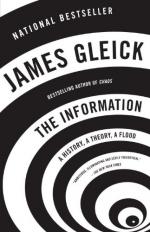
|
| Name: _________________________ | Period: ___________________ |
This test consists of 15 multiple choice questions and 5 short answer questions.
Multiple Choice Questions
1. How does Gleick see the universe?
(a) As a colossal Internet.
(b) As an infinite stream of knowledge.
(c) As a giant computer.
(d) As a cloud of quantum particles.
2. What is the most probable state for an arrangement of molecules in a system?
(a) In a jumble.
(b) In an arc.
(c) Constantly and randomly movement.
(d) In an organized line.
3. What results when a closed system's temperature evens out?
(a) There is no change.
(b) More work can be accomplished.
(c) The system fails.
(d) No work could be done.
4. Recognizing a famous painting like the Mona Lisa is attributed to what factor?
(a) Bits.
(b) The meme.
(c) Memory.
(d) Education.
5. What can the amount of information in a message be expressed in?
(a) By the computation that produces it.
(b) By the algorithm that produces it.
(c) By its integral number.
(d) By the bits it contains.
6. How can memes be altered?
(a) Through mutation.
(b) Through manipulation.
(c) Through mutation and manipulation.
(d) After a serious illness.
7. What did Shannon bring to one of his meetings?
(a) A computer.
(b) A newly developed programming language.
(c) A computer scientist.
(d) A robot.
8. What are memes?
(a) Bits of information.
(b) Chromosomal genes.
(c) Self-cloning genes.
(d) Repressive genes.
9. What is the normal state of quantum particles?
(a) The exist in an electrically charged state.
(b) They exist in an unknown state.
(c) They exist in a subdued state.
(d) They exist in a cloud of probable states all at once.
10. How did Landauer disprove von Neumann's theory on the energy cost of information?
(a) Flipping a bit from one state to another did not change entropy..
(b) There was no lost of vitality.
(c) Through extensive experiments.
(d) He was supported by others who agreed with him.
11. The existence of what entity as a basic element of genetics had been theorized before the mechanics of genetic reproduction was fully understood?
(a) RNA.
(b) The Genome.
(c) A gene.
(d) DNA.
12. The elements of DNA come in predictable proportions of what shape?
(a) Infinity symbol.
(b) Double helix.
(c) Double spiral.
(d) Figure eight.
13. Why are people able to recall the name of a tune?
(a) People love music.
(b) They associate music with certain events.
(c) It makes them remember good times.
(d) Recollection of tunes is stored in memes.
14. What does the size of the algorithm indicate about the number?
(a) Its capacity for computation.
(b) Its computable nature.
(c) Its simplicity.
(d) Its complexity.
15. What can a computable number be compressed into?
(a) An algorithm.
(b) 0s and 1s.
(c) A byte.
(d) A standard calculation.
Short Answer Questions
1. Where is DNA found?
2. What did Seth Lloyd, a quantum engineer at MIT, base his estimates on the universe on?
3. What is a fundamental problem in quantum mechanics?
4. It had long been noted that physical traits were inheritable and that they had something to do with what other human element?
5. What does the author compare the famous library to?
|
This section contains 539 words (approx. 2 pages at 300 words per page) |

|




